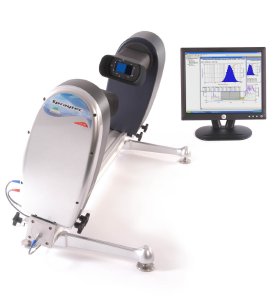Apr 9 2008
At this year’s Respiratory Drug Delivery conference (RDD 2008, 11-15 May; Scottsdale, Arizona), a poster presentation from workers at Malvern Instruments and Dr David Morton of the Monash Institute of Pharmaceutical Sciences, describes collaborative studies on the Investigation of Powder Dispersion from a Dry Powder Inhaler Using Laser Diffraction.
 The Malvern Spraytec particle characterization system.
The Malvern Spraytec particle characterization system.
Malvern’s Spraytec particle characterization system was used for this work, which probed the dynamics of dispersion of various model powder formulations from an inhaler device. The authors conclude that laser diffraction is a screening tool of significance to the Dry Powder Inhaler (DPI) developer, allowing particle size measurements to be made in real time during inhaler actuation and enabling the dispersion process to be followed closely. Spraytec, with its new version software, will be on display throughout the conference.
Spraytec is a high throughput particle characterization system used to analyze a wide range of pharmaceutical and industrial aerosols and sprays. It delivers real-time, high-speed measurements, enabling the detailed characterization of spray behaviour over an extremely wide particle size range. New Spraytec software extends the system’s data capture and processing capabilities, providing the automatic calculation of the variability in spray particle size at different time-points during device actuation. This provides additional insight into the operation of inhaler devices, promoting a Quality by Design (QbD) approach to efficient product development.
Dr David Morton and his team at Monash University will also present further novel work* at RDD 2008, demonstrating advances in understanding the fundamental mechanisms inherent in powder dispersion. By applying the fast measurement speeds and wide particle sizing ranges available with the Spraytec system, they have been able to reveal time-dependent de-aggregation and dispersion processes which occur during DPI actuation. Furthermore, they have used this technique to demonstrate how the surface modification of fine lactose powders can provide a substantial improvement in flow properties.